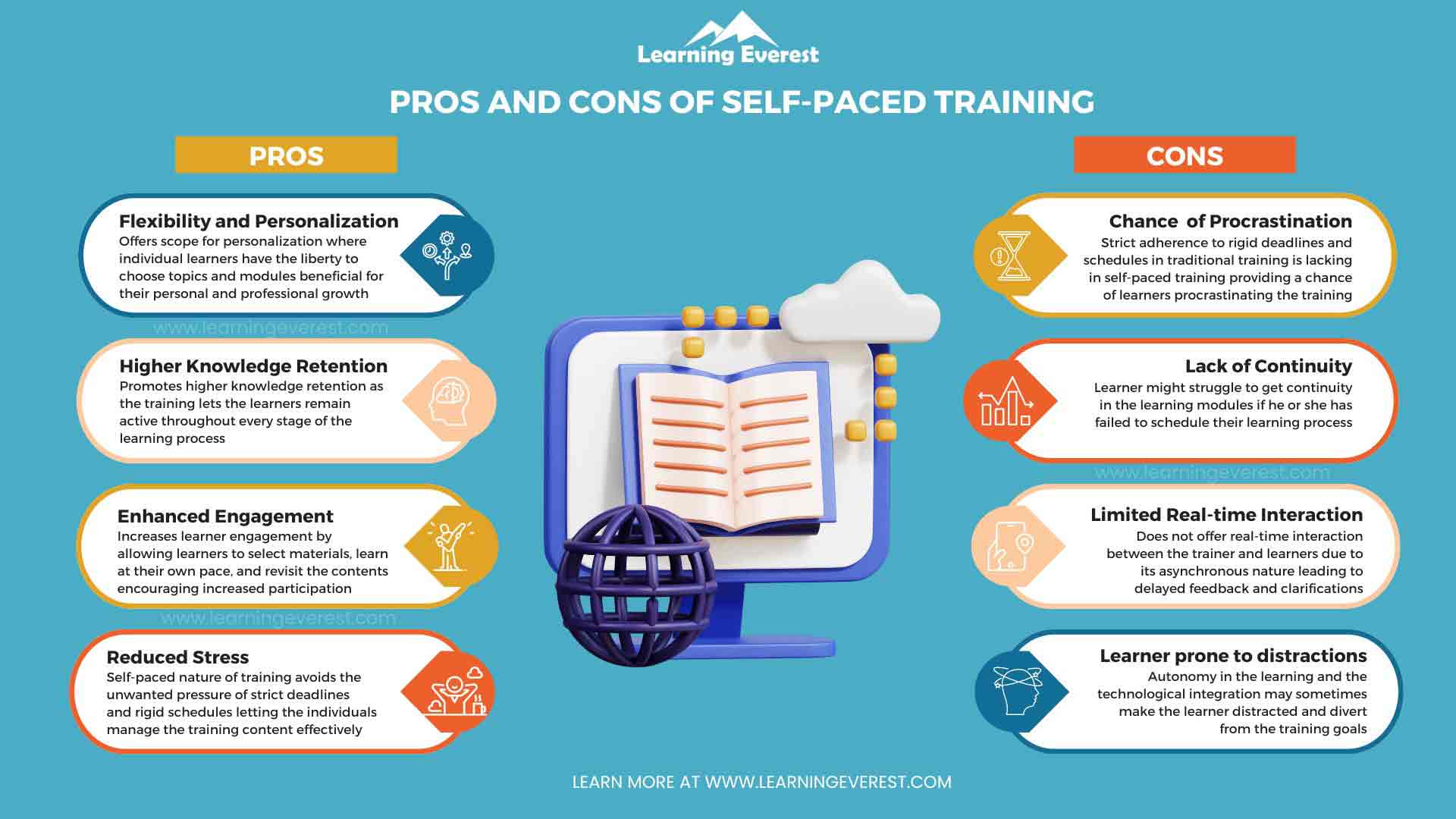Understand the definition of training at your own pace
Each learner is unique in his learning styles, his needs and his pace. Effective training focuses on satisfying the individual needs of all differentiated learners according to learning styles and adaptability. Training at your own pace is a training approach that offers learners autonomy to teach their convenience and their pace. Unlike the traditional approach to training which obliges learners to be present in a fixed place and time, this approach gives learners the possibility of planning their learning time to any physical place.
In addition, rhythm learning is an asynchronous learning that presents itself in a range of formats such as videos, online courses and interactive modules allowing learners to select according to their needs and preferences leading to a personalized learning experience.
Evaluation of the advantages and disadvantages of training at your own pace
To implement a training method adapted to the transmission of knowledge on a particular subject, it is crucial to understand and assess the advantages and disadvantages of the method. Training at your own pace offers significant advantages, including autonomy and flexibility. However, there are some Challenges encountered by training approach that trainers and learners must be aware when they opt for the method. Evaluate the advantages and disadvantages of the training method.


For the advantages and disadvantages of training at your own pace
Pros
The main training professionals at your own pace are:
- Flexibility and personalization: The most distinctive characteristic of training at your own pace is its flexibility which benefits learners to undertake training at their convenience. According to the LinkedIn workplace report, 2018 “58% of employees prefer to learn at their own pace”. In addition, training offers a possibility of personalization where individual learners have the freedom to choose subjects and modules that are beneficial for their personal and professional growth.
- Higher knowledge of knowledge: Knowledge retention is defined as an individual's ability to remember and recall the information reached for a long time. Training at your own pace promotes higher retention of knowledge because training allows learners to remain active throughout each stage of the learning process. The acquired knowledge chosen for a longer period contributes to improving long -term memory. Training at your own pace is generally conducted using online platforms and statistical data suggested that “online learning increases retention rates from 25 to 60%”. (Source: Elearning industry))
- Improved commitment: Training at your own pace increases training process Allows learners to select equipment, learn them at their own pace and review the content if necessary, thus encouraging increased participation in learners. In addition, the autonomy of learners to plan the learning process increases their objective and motivates critical thinking.
- Reduced stress: The auto-rhythm of the training avoids unwanted pressure from strict deadlines and rigid schedules allowing individuals to effectively manage the content of the training. The convenience associated with learners involved in training helps them revise concepts before undertaking assessments and evaluation reducing their stress.
Disadvantages
- Chance of procrastination: Strict membership in rigid deadlines and hours in traditional training is lacking in training at your own pace, which can lead to a chance that learners pronounce the training. The learner must be self-discipline to achieve the desired results of training at your own pace.
- Loss of continuity: The learner could find it difficult to obtain continuity in the learning modules if he has failed to plan his learning process. The learner may experience gaps and difficulties in connecting concepts in the learning process and the problems to maintain the previous knowledge of learning following a disturbed schedule.
- Limited interaction in real time: The training at your own pace does not offer real -time interaction between the trainer and the learners because of his asynchronous nature. This can lead learners to receive delayed comments and clarifications during the learning process. The learner can sometimes feel isolated in the learning experience Due to the lack of face -to -face interaction.
- Learning subjects to distractions: Autonomy in learning and technological integration can sometimes make the learner distract and detach themselves from the training objectives. Learners lacking appropriate orientation of the objectives can be distracted by the excessive flexibility of training at your own pace.
Discover the advice for effective training at your own pace
Despite the challenges of training at your own pace, the implementation of certain Steps in the training process Can help effectively solve these drawbacks. These tips offer a robust way to help learners follow a defined track without discovering gaps and distractions. Let's discover the essential advice for productive training at your own pace.
Organize
Training at your own pace can be effective if the program is well organized. This includes information of the objectives and results of the training learners To allow them to choose the relevant information necessary for the program. In addition, trainers can ensure that learners are motivated to learn by providing mentorship and including them in study groups to avoid isolation and promote collaboration.
Integrate several channels
Efficient training includes several channels to make learning interesting. This may include elearning Modules, AR, VR, video modules, text, simulations and discussion forums. The training program can use a Learning management system To provide a platform to take advantage of these channels.
Promote commitment
To avoid monotony in training at your own pace, encourage engaging activities in the training program. Activities such as interactive sessions, gamification, Infographic with relevant informationand virtual laboratories to promote practical learning. The promotion of commitment to the learning process benefits learners to maintain information of a longer duration.
Provide comments and support
Gentle -time feedback is crucial for the success of training at your own pace. The lack of backward and immediate feedback is one of the reasons why learners abstain from training at your own pace. Training programs which incorporate automated comments can solve this problem to some extent. In addition, trainers can plan feedback sessions for learners at their convenience.
Conclusion
The training approach is a training at your own pace which offers autonomy to learners by letting them learn in their time and their workplace. This flexibility in rhythm and physical location differentiates it from traditional training approaches. The advantages of training at your own pace are offered flexibility and personalization, higher knowledge of knowledge, improved commitment and a reduction in stress. On the other hand, the drawbacks of the approach are that there is a risk of procrastination on the part of learners, loss of continuity, limited interaction in real time and learners being subject to distractions.
To overcome these disadvantages and have a hard -hitting learning experience, trainers can adopt some advice in the program, such as organizing training by informing training objectives and results, integration of several channels such as Elearning, AR, VR modules, videos, simulations and discussion forums, promotion of engagement by including gamification, virtual laboratories and Infographics in training and provide comments and support. Training at your own pace can be a precious tool for people who seek to improve their professional and personal life. By recognizing the potential challenges of this approach and implementing effective strategies, learners can effectively use training in your learning.
Infographic
Knowledge verification!
Frequently asked questions (FAQ)
What is training at your own pace?
Training at your own pace is a training approach that offers learners autonomy to teach their convenience and their pace.
How is training at your own pace different from traditional training?
The training at your self -proclaimed rate offers learners the possibility of planning their learning time at any physical place, unlike the traditional approach to training which requires that learners are present in a place and at a fixed time.
What are the advantages of training at your own pace?
The advantages of training at your own pace are offered flexibility and personalization, higher knowledge of knowledge, improved commitment and a reduction in stress.
What are the disadvantages of training at your own pace?
The disadvantages of the approach are that there is a risk of procrastination on the part of learners, loss of continuity, limited interaction in real time and learners being subject to distractions.



